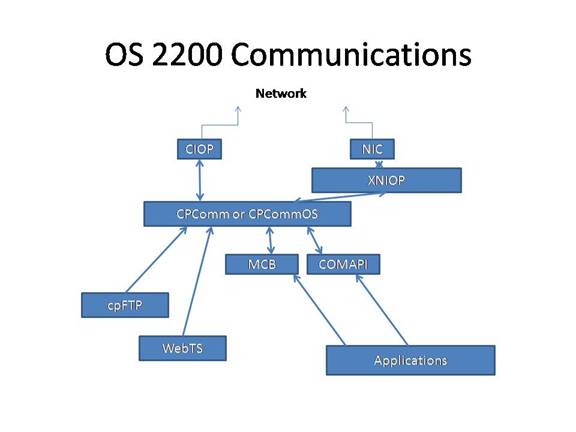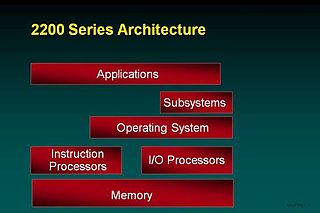The OS 2200 communications management system includes CPComm and MCB along with many programs that provide communications related functions such as file transfer, e-mail, and distributed transaction processing protocols.
Contents

The OS 2200 communications management system includes CPComm and MCB along with many programs that provide communications related functions such as file transfer, e-mail, and distributed transaction processing protocols.

CPComm executes as a real time program in a background run. [1] CPComm implements the protocol stacks.
CPComm communicates with the CIOP (Communications I/O Processor) to connect to networks. CPcommOS is a variant for 2200 Series systems implemented on Intel architectures. In the most recent systems only various speeds of Ethernet communications are supported. Previous systems supported ATM and FDDI but these were dropped through lack of interest.
CPComm and the Exec jointly handle authentication of connection requests and authorization for users and terminals to connect to time-sharing, and the various transaction application groups. SSL is supported for every connection. CPComm has software implementations of the encryption algorithms required for SSL.
CPComm includes the protocols and connections to time-sharing and transaction message queues. One of the most heavily used legacy protocols is INT1 which is a TCP/IP variant of the UNISCOPE/UTS green-screen terminal protocol.

Uniscope was a class of computer terminals made by Sperry Rand Corporation, Univac Division, and successors since 1964 that were normally used to communicate with Univac mainframes. As such, it was the successor to various models of Teletype. Due to the text color on the original models, these terminals are informally known as green screen terminals.
TCP/IP v4 and TCP/IP v6 along with SNMP v1 and v3 are supported by CPComm.
The Message Control Bank (MCB) is a protected subsystem that implements the message queues for transaction processing. It communicates with the transaction scheduler in the Exec. It also provides the APIs for applications to send and receive messages from the queues. [2]
COMAPI is a sockets implementation for OS2200. It is a protected subsystem that provides APIs for programs that wish to communicate directly with the network. In addition to all the traditional sockets APIs for C, APIs are provided for all the other programming languages. [3]
cpFTP is a program that provides both client and server FTP capability for OS 2200. [4]
WebTS, the OS 2200 Web Transaction Server, is a full implementation of the HTTP and HTTPS protocol stacks. Server scripting using Java applets is supported, but the primary usage of WebTS is its full integration with OS 2200 including all security and transaction processing. [5]
Transactions initiated via WebTS are subject to the same authentication as any other transaction and run with the same performance, scaling, and recovery. Such transactions may use the CGI APIs for communications with the client. Transactions developed for OS 2200 using the DPS display manager, typically require no changes or even recompilation to be fully operational with Web interfaces concurrently with terminals. Changes to DPS combined with client-side Java applets make everything transparent to the transaction program. [6]
The Java Message Service (JMS) API is a Java message-oriented middleware API for sending messages between two or more clients. It is an implementation to handle the producer–consumer problem. JMS is a part of the Java Platform, Enterprise Edition, and was defined by a specification developed at Sun Microsystems, but which has since been guided by the Java Community Process. It is a messaging standard that allows application components based on Java EE to create, send, receive, and read messages. It allows the communication between different components of a distributed application to be loosely coupled, reliable, and asynchronous.

In computer science, inter-process communication or interprocess communication (IPC) refers specifically to the mechanisms an operating system provides to allow the processes to manage shared data. Typically, applications can use IPC, categorized as clients and servers, where the client requests data and the server responds to client requests. Many applications are both clients and servers, as commonly seen in distributed computing. Methods for doing IPC are divided into categories which vary based on software requirements, such as performance and modularity requirements, and system circumstances, such as network bandwidth and latency.
An application layer is an abstraction layer that specifies the shared communications protocols and interface methods used by hosts in a communications network. The application layer abstraction is used in both of the standard models of computer networking: the Internet Protocol Suite (TCP/IP) and the OSI model. Although both models use the same term for their respective highest level layer, the detailed definitions and purposes are different.
In computing, the Windows Sockets API (WSA), later shortened to Winsock, is a technical specification that defines how Windows network software should access network services, especially TCP/IP. It defines a standard interface between a Windows TCP/IP client application and the underlying TCP/IP protocol stack. The nomenclature is based on the Berkeley sockets API model used in BSD for communications between programs.
Explicit Congestion Notification (ECN) is an extension to the Internet Protocol and to the Transmission Control Protocol and is defined in RFC 3168 (2001). ECN allows end-to-end notification of network congestion without dropping packets. ECN is an optional feature that may be used between two ECN-enabled endpoints when the underlying network infrastructure also supports it.
In computer science, message queues and mailboxes are software-engineering components used for inter-process communication (IPC), or for inter-thread communication within the same process. They use a queue for messaging – the passing of control or of content. Group communication systems provide similar kinds of functionality.
Message-oriented middleware (MOM) is software or hardware infrastructure supporting sending and receiving messages between distributed systems. MOM allows application modules to be distributed over heterogeneous platforms and reduces the complexity of developing applications that span multiple operating systems and network protocols. The middleware creates a distributed communications layer that insulates the application developer from the details of the various operating systems and network interfaces. APIs that extend across diverse platforms and networks are typically provided by MOM.
Microsoft Message Queuing or MSMQ is a message queue implementation developed by Microsoft and deployed in its Windows Server operating systems since Windows NT 4 and Windows 95. Windows Server 2016 and Windows 10 also includes this component. In addition to its mainstream server platform support, MSMQ has been incorporated into Microsoft Embedded platforms since 1999 and the release of Windows CE 3.0.
IBM MQ is a family of message-oriented middleware products that IBM launched in December 1993. It was originally called MQSeries, and was renamed WebSphere MQ in 2002 to join the suite of WebSphere products. In April 2014, it was renamed IBM MQ. The products that are included in the MQ family are IBM MQ, IBM MQ Advanced, IBM MQ Appliance, IBM MQ for z/OS, and IBM MQ on IBM Cloud.
Push notifications are small messages that can reach audiences anywhere and anytime. There’s a difference between pop-ups and push notifications. Pop-ups appear only when audiences are on the site they belong to. Push messages are independent of sites. They are associated with web browsers and apps.
In computing, Advanced Program to Program Communication or APPC is a protocol which computer programs can use to communicate over a network. APPC is at the application layer in the OSI model, it enables communications between programs on different computers, from portables and workstations to midrange and host computers. APPC is defined as VTAM LU 6.2
Teleprocessing Network Simulator (TPNS) is an IBM licensed program, first released in 1976 as a test automation tool to simulate one or many network terminal(s) to a mainframe computer system, for functional testing, regression testing, system testing, capacity management, benchmarking and stress testing. In 2002, IBM re-packaged TPNS and released Workload Simulator for z/OS and S/390 (WSim) as a successor product.
OS 2200 is the operating system for the Unisys ClearPath Dorado family of mainframe systems. The operating system kernel of OS 2200 is a lineal descendant of Exec 8 for the UNIVAC 1108. Documentation and other information on current and past Unisys systems can be found on the Unisys public support website.

The figure shows a high-level architecture of the OS 2200 system identifying major hardware and software components. The majority of the Unisys software is included in the subsystems and applications area of the model. For example, the database managers are subsystems and the compilers are applications.

The OS 2200 database managers are all part of the Universal Data System (UDS). UDS provides a common control structure for multiple different data models. Flat files, network (DMS), and relational (RDMS) data models all share a common locking, recovery, and clustering mechanism. OS 2200 applications can use any mixtures of these data models along with the high-volume transaction file system within the same program while retaining a single common recovery mechanism.

OS 2200 supports all commonly used, and many not so commonly used, distributed processing protocols, APIs, and development technology.
OS 2200 has had several generations of compilers and linkers in its history supporting a wide variety of programming languages. In the first releases, the Exec II assembler (SLEUTH) and compilers were used. The assembler was quickly replaced with an updated version (ASM) designed specifically for the 1108 computer and Exec 8 but the early compilers continued in use for quite some time.
WebSocket is a computer communications protocol, providing full-duplex communication channels over a single TCP connection. The WebSocket protocol was standardized by the IETF as RFC 6455 in 2011, and the WebSocket API in Web IDL is being standardized by the W3C.
IBM WebSphere Application Server for z/OS is one of the platform implementations of IBM's WebSphere Application Server family. The latest version is Version 9.0.
MQTT is an ISO standard publish-subscribe-based messaging protocol. It works on top of the TCP/IP protocol. It is designed for connections with remote locations where a "small code footprint" is required or the network bandwidth is limited. The publish-subscribe messaging pattern requires a message broker.